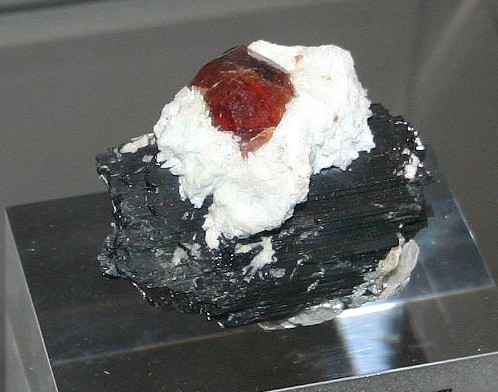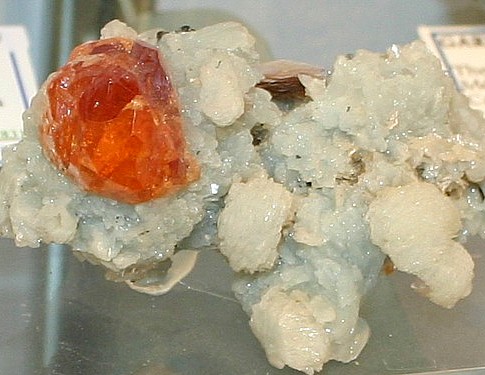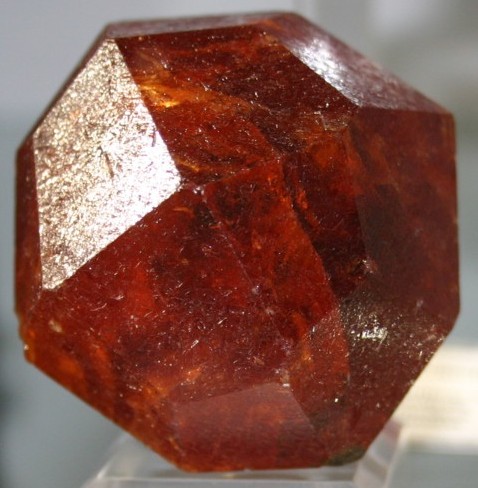|
.
Spessartite Mineral Facts:
Chemical Formula:
Mn3Al2(SiO4)3
Manganese aluminum garnet. Ferrous iron often replaces the manganese and
ferric iron some of the aluminum. The name is taken from the city
of Spessart, a locality in German Bavaria where this type of garnet was
first identified. Also known as Spessartine garnet.
Colors:
Deep orange to
brownish red.
The purest specimens
of this manganese aluminum garnet, with little iron content are a light
yellow orange color. The darkest specimens generally contain the highest
amounts of iron.
Hardness:
7
Density:
about 3.8
Cleavage:
None
Crystallography: Isometric, hexoctahedral
Usually distinctly
crystallized; also in rounded grains.
When crystalized, commonly forms dodecahedron and trapezohedron, often
in combination. Hexoctahedron observed at times.
Luster:.
Vitreous glassy
luster. It is transparent or translucent. The streak is always white or
whitish, and the fracture subconchoidal or
uneven.
Optics:
(Refractive Index): = 1.8105
|
 |
|
Composition,
Structure and Associated Minerals:
Spessartite
is found in acid igneous rocks and in various schist formations. The largest
and finest specimens, including nearly all gem quality material are found in
granitic pegmatites where it is associated with albite feldspar, tourmaline
and various mica minerals. Spessartite also occurs in the igneous rock,
rhyolite where it is found in the lithophyse cavities in that rock.
Spessartine from Rhyolite can make some very well formed specimens, but the
color is normally very dark, ranging from dark red -brown to dark violet
red.
Spessartite is hyacinth or orange red, with occasionally a tinge of brown or
violet. The purest varieties are yellow, but since there is nearly always an
admixture of one of the iron molecules, the more usual color, is reddish
orange. Those with a larger almandine content are more reddish, to red brown
in hue. The mineral is usually transparent.
Identification and Diagnostics
Spessartite
when fused with sodium carbonate gives a bluish green bead (positive test
for manganese).
In the blowpipe flame it fuses
fairly easily to a black, nonmagnetic mass. Garnets, when in crystals, are easily distinguished
from other similarly crystallizing substances by their characteristic
isometric crystals, color and hardness, etc. Massive garnet may resemble vesuvianite,
sphene, zircon or
tourmaline. It is distinguished from
zircon by its easier fusibility and from vesuvianite by its more difficult
fusibility; from tourmaline by its higher specific gravity, and from sphene
by the reaction from titanium.
It frequently requires a chemical
analysis to positively distinguish between the different members of the
garnet group, or the percentages of each molecule in an individual specimen.
|
 |
|
|
Occurrence,
Localities and Origins:
Its principal known
occurrences are in Brazil and Africa. In both locations the mineral is mined
from pegmatites. Its best known occurrences in the United States are in
granite, at Haddam, Conn., in pegmatite, at Amelia Court House, Virginia,
and near Ramona in San Diego County, California. It is also found in the
lithophyse of rhyolites, near Nathrop, in Colorado, in Maine, and near Ely,
Nevada, where it forms as the product of pneumatolitic processes, in
openings lined with tridymite silica. The location near Ely is known as
Garnet Hill and is a well known rock hound location which is open to the
public. Breaking open the pink to gray rhyolite yields small crystals of
spessartine garnet, and nice specimens are not especially difficult to
acquire. Spessartine from garnet in rhyolite cavities in normally very dark
colored, and while quite suitable for attractive mineral collector
specimens, is too dark in color for any gem usage.
It is
among the rarer forms of garnet, and sees only a little gemstone use in
spite of its beauty and high refractive index. Gems from Brazil or Africa
are sometimes offered for sale. They tend to be smaller in size that some
other garnet gems. Its specimens can be well formed and large, so the better
ones are much valued and appreciated by mineral collectors.
Return to the
Mineral Collectors Information Page |
|






